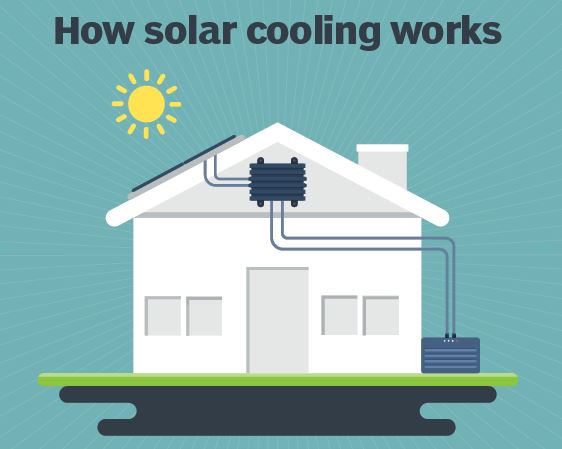Energy Saving by using Solar Cooling in Buildings (2012)
Solar Cooling in Buildings and Energy Saving Dissertation – Air conditioning is one of major consumers of electricity in many regions of the world. The percentage of use is higher in hot climate because of the high demand for cooling that is required for the thermal comfort of occupants in building. This results in a dramatic increase in demand for electricity on hot summer days, which causes an undesirable increase in the use of fossil fuel and furthermore threatens the stability of electricity grids.
Recently areas of Europe have seen a number of electric power shortages in summer during periods of peak use of air conditioning. Due to the need for cooling applications such as air conditioning in summer, which usually correlates with the availability of high levels of solar radiation, solar energy seems an obvious energy source for cooling purposes; this could be used to replace a large portion of the electrical energy required for convection air conditioning. Solar cooling might also be a way to reduce peak demand for electrical power because the majority of air conditioning systems use vapour compression systems driven by grid-electricity.
In addition many solar cooling systems are constructed in ways that eliminate the need for CFC refrigerants that cause ozone depletion and the green house effect. Therefore, solar cooling will undoubtedly play an increasing role in zero energy and green building design in the future. Solar cooling is not yet widely available, so it is important to understand the specific barriers to its rise to prominence, and as a result determine the best strategies to help overcome these barriers.
This dissertation investigated the potential for the solar cooling of buildings in hot climate regions. It also presents a case study, focusing on a building in the Sultanate of Oman to compare energy uses for cooling load by contrasting conventional air conditioning system and solar cooling techniques.
- 12,000 words – 82 pages in length
- Good use of literature
- Well written throughout
- Good analysis of the subject area
- Ideal for building and architecture students
1: Introduction
General Introduction
Aims and Objectives
Outline of the Dissertation
2: Literature Review
Introduction
Energy Consumption in Buildings
Global Warming
Energy Efficiency in Buildings
Energy Demand in Buildings in the Middle East
Politics and Energy Consumption in Buildings
Solar Cooling Systems
Adsorptions
Desiccants
Summary
3: Solar Absorption System
History
Air Conditioning and Refrigerant
Absorption Cooling Machines
Solar Cooling Using the Absorption System
Applications
Types
Single-Effect
Double-Effect
Triple-Effect
Efficiencies
Benefits
Limitations
Summary
4: Case Study Analysis
Location
Climate Data
Solar Energy
Case Study
Economical Analysis
Economic Analysis Methods
Systems Overview
Summary and Discussion
5: System Analysis
System Sizing and Design
Basic Parameters
System Description
System Integration
Economic Evaluation and System Comparison
Economic Evaluation
Assumptions and Mythology
Non Economic Analysis
Summary of the Results
6: Conclusion
Conclusion
Recommendations for Future Research
Appendix Section
References

